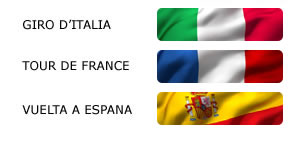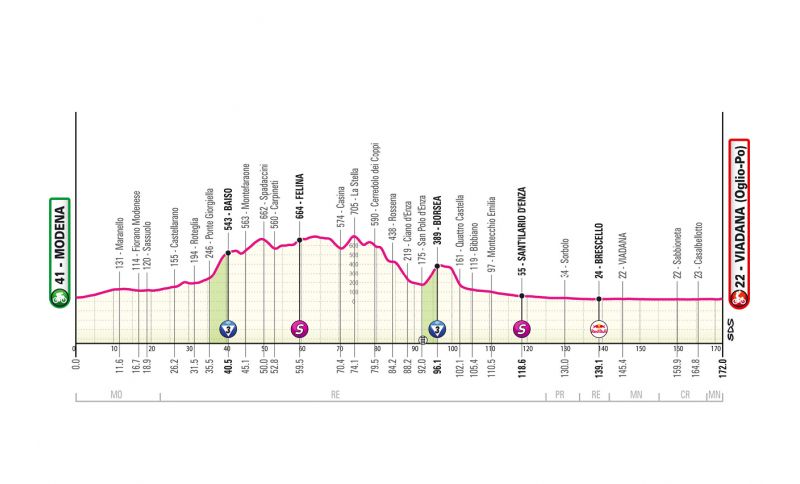

The Giro d'Italia leaves the Apennines and launches into the classic crossing of the Po Valley: the twelfth stage will take the pink race from Modena to Viadana for 172 km with an elevation gain of 1,700 meters to tackle.
to follow the entire stage live starting at 1:15 PM CLICK HERE
The elevation data shows that it's not exclusively a flat stage, although it's really difficult to imagine that sprinters will let the opportunity to fight for victory slip away. The stage is challenging for the first 100 km and subsequently completely flat until the finish. In the first part, the Matildic Castles in the Modena hinterland are skirted to reach Quattro Castella from where the road becomes absolutely flat. First passage at the finish for a circuit of about 27 km always on wide and predominantly straight roads. In the last 3 km, there is practically only the last curve about 500 m from the finish.
THE TERRITORY. Great beauty and much more. The twelfth stage of the Giro connects countless aspects of the Bel Paese. And tells their story. Starting with Modena, the starting city, which entered the World Heritage List back in 1997. The Unesco site of Modena includes the Cathedral, the Ghirlandina tower and Piazza Grande, with the buildings overlooking it, particularly the Archbishop's Palace and the Municipal Palace.
Modena, however, is much more. For gourmets, it's the heart of production of the renowned Traditional Balsamic Vinegar DOP and one of the cornerstones of the so-called Food Valley, the vast area of origin and processing of some of the most appreciated food excellences in the country, particularly cured meats and sausages, which can be tasted during the day directly in the production locations.
Modena is also a city of music: visiting Luciano Pavarotti's birthplace, now transformed into a museum dedicated to the artist, is emotional. And it's a city of motors: Enzo Ferrari was born here, but besides visiting the museum dedicated to the unforgettable "Drake", there are many factories, museums and private collections to visit: the Maserati showroom, the Umberto Panini Vintage Car and Motorcycle Museum, the Stanguellini Museum, the Righini collection, Pagani Automobili.
So we start at full speed and quickly arrive in Maranello, the heart of the Ferrari myth where we stop to admire the museum dedicated to the Prancing Horse and visit the factories where the "reds" are born.
Sassuolo is the world capital of ceramics, an excellence that can be discovered by visiting workshops and production facilities scattered in the so-called "Ceramicland".
Taking a leap back in time of almost a millennium, we enter the Matildic Lands, consecrated to Matilde di Canossa who dominated these areas in the 12th century. From that era remain imposing manors and towns of great suggestion: Rossena, Carpineti, Montecchio Emilia and Quattro Castella are just some of the places that invite a journey through time.
Then the stage decisively points north. The delicious treasures of the Food Valley wink roadside until Brescello, the town where the literary and cinematographic epic of Peppone and Don Camillo was born, to whom a museum is dedicated that - through memorabilia and memories - brings back - with sympathy and nostalgia - the Italy of the post-World War II period.
The wonderful Renaissance village of Sabbioneta, also included by UNESCO in the World Heritage List, must be visited carefully: the "ideal city" designed in the 16th century continues to amaze. And to seduce.
A long sprint through the Mantua countryside brings us back to the banks of the Po, in Viadana. Here we taste the delicacies of this corner of Lombardy, first among all pumpkin ravioli. Whose very long history is retraced in the halls of MuVi (Viadana Museums), a complex that hosts the Antonio Parazzi Civic Archaeological Museum, the Adolfo Ghinzelli City Museum, which traces the historical events of Viadana and its surrounding territory, and the Civic Gallery of Contemporary Art. Not far from the center is the interesting Ecomuseum of Water Lands between the Oglio and Po rivers, set up in a historic hydraulic plant to enhance the agricultural and artisan traditions of the river territory.

Se sei giá nostro utente esegui il login altrimenti registrati.